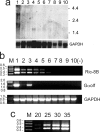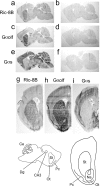Ric-8B, an olfactory putative GTP exchange factor, amplifies signal transduction through the olfactory-specific G-protein Galphaolf
- PMID: 15829631
- PMCID: PMC6724935
- DOI: 10.1523/JNEUROSCI.4595-04.2005
Ric-8B, an olfactory putative GTP exchange factor, amplifies signal transduction through the olfactory-specific G-protein Galphaolf
Abstract
The olfactory system is able to detect a large number of chemical structures with a remarkable sensitivity and specificity. Odorants are first detected by odorant receptors present in the cilia of olfactory neurons. The activated receptors couple to an olfactory-specific G-protein (Golf), which activates adenylyl cyclase III to produce cAMP. Increased cAMP levels activate cyclic nucleotide-gated channels, causing cell membrane depolarization. Here we used yeast two-hybrid to search for potential regulators for Galphaolf. We found that Ric-8B (for resistant to inhibitors of cholinesterase), a putative GTP exchange factor, is able to interact with Galphaolf. Like Galphaolf, Ric-8B is predominantly expressed in the mature olfactory sensory neurons and also in a few regions in the brain. The highly restricted and colocalized expression patterns of Ric-8B and Galphaolf strongly indicate that Ric-8B is a functional partner for Galphaolf. Finally, we show that Ric-8B is able to potentiate Galphaolf-dependent cAMP accumulation in human embryonic kidney 293 cells and therefore may be an important component for odorant signal transduction.
Figures





Similar articles
-
Conditional Deletion of Ric-8b in Olfactory Sensory Neurons Leads to Olfactory Impairment.J Neurosci. 2017 Dec 13;37(50):12202-12213. doi: 10.1523/JNEUROSCI.0943-17.2017. Epub 2017 Nov 8. J Neurosci. 2017. PMID: 29118104 Free PMC article.
-
Ric-8B interacts with G alpha olf and G gamma 13 and co-localizes with G alpha olf, G beta 1 and G gamma 13 in the cilia of olfactory sensory neurons.Mol Cell Neurosci. 2008 Jul;38(3):341-8. doi: 10.1016/j.mcn.2008.03.006. Epub 2008 Apr 1. Mol Cell Neurosci. 2008. PMID: 18462949
-
Ric-8B promotes functional expression of odorant receptors.Proc Natl Acad Sci U S A. 2006 Jun 13;103(24):9310-4. doi: 10.1073/pnas.0600697103. Epub 2006 Jun 5. Proc Natl Acad Sci U S A. 2006. PMID: 16754875 Free PMC article.
-
Ric-8 regulation of heterotrimeric G proteins.J Recept Signal Transduct Res. 2013 Jun;33(3):139-43. doi: 10.3109/10799893.2013.763828. Epub 2013 Feb 6. J Recept Signal Transduct Res. 2013. PMID: 23384070 Free PMC article. Review.
-
Odorant Receptors.In: Menini A, editor. The Neurobiology of Olfaction. Boca Raton (FL): CRC Press/Taylor & Francis; 2010. Chapter 7. In: Menini A, editor. The Neurobiology of Olfaction. Boca Raton (FL): CRC Press/Taylor & Francis; 2010. Chapter 7. PMID: 21882436 Free Books & Documents. Review.
Cited by
-
Dictyostelium Ric8 is a nonreceptor guanine exchange factor for heterotrimeric G proteins and is important for development and chemotaxis.Proc Natl Acad Sci U S A. 2013 Apr 16;110(16):6424-9. doi: 10.1073/pnas.1301851110. Epub 2013 Apr 1. Proc Natl Acad Sci U S A. 2013. PMID: 23576747 Free PMC article.
-
Deep sequencing of the murine olfactory receptor neuron transcriptome.PLoS One. 2015 Jan 15;10(1):e0113170. doi: 10.1371/journal.pone.0113170. eCollection 2015. PLoS One. 2015. PMID: 25590618 Free PMC article.
-
Enhancement of transcription efficiency by TAR-Tat system increases the functional expression of human olfactory receptors.PLoS One. 2024 Jun 25;19(6):e0306029. doi: 10.1371/journal.pone.0306029. eCollection 2024. PLoS One. 2024. PMID: 38917199 Free PMC article.
-
Olfactory receptors in non-chemosensory tissues.BMB Rep. 2012 Nov;45(11):612-22. doi: 10.5483/bmbrep.2012.45.11.232. BMB Rep. 2012. PMID: 23186999 Free PMC article. Review.
-
Regulation, Signaling, and Physiological Functions of G-Proteins.J Mol Biol. 2016 Sep 25;428(19):3850-68. doi: 10.1016/j.jmb.2016.08.002. Epub 2016 Aug 8. J Mol Biol. 2016. PMID: 27515397 Free PMC article. Review.
References
-
- Belluscio L, Gold GH, Nemes A, Axel R (1998) Mice deficient in G(olf) are anosmic. Neuron 20: 69-81. - PubMed
Publication types
MeSH terms
Substances
LinkOut - more resources
Full Text Sources
Other Literature Sources
Molecular Biology Databases
